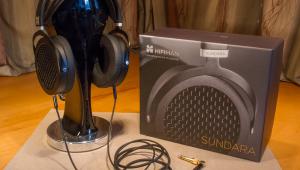| Columns Retired Columns & Blogs |
Stax SR-Omega headphones

Ah, yes, headphones again. The market for super–high-end headphones must be small, but manufacturers nevertheless keep introducing new designs. At least two manufacturers—Stax and Sennheiser—seem to have carved out a big chunk of this market for themselves, and are currently slugging it out with their respective takes on the best that electrostatic headphones have to offer. Headphones aren't for everyone, but if you're a fan of private listening (or are one of that small but vociferous audiophile subset—a binaurophile), you need to pay attention to what these two companies are up to. In this review I listen to Stax's top-of-the-line SR-Omegas.
The Stax SR-Omegas look quite different from earlier Stax headphones. The large, round earcups of the SR-Omegas distinguish them immediately from, for example, the rectangular earcups of the SR-Lambdas. For my ears, the SR-Omegas were a much more comfortable fit (though they are slightly heavier). With the Lambdas, my ears seemed to just fit, and they would begin to itch after about an hour's listening. The SR-Omegas were just as comfortable after four hours as they were when I first put them on. Though the earpads are of synthetic leather, they never got sweaty (though my listening was not done in the summer).
The larger diaphragms of the SR-Omegas are designed to extend the low-frequency performance. The electrodes are of gold-plated copper mesh, the diaphragm of 1.5µm polyester. The earpiece housings are milled from solid aluminum, which is then anodized. A new, lower-capacitance cable of PC-OCC copper was also developed for the SR-Omegas.
The tubed SRM-T1S Driver Unit furnished with the SR-Omegas is very similar to the SRM-T1, which is the normal companion to the next model down in the Stax range, the SR-Lambda Signature T1. While some updating of sound quality is claimed in the limited tech information that was available to me, no specific improvements are spelled out. Switching for the two inputs has been added in the newer model, however, and one of the inputs now has a balanced option (I did all of my listening in the unbalanced mode). Since the original SRM-T1 had a differential input (dual-FET input stages on the SRM-T1S drive the vacuum-tube output stages, as in the original T1), a balanced input could be added without the use of transformers or additional phase inverters.
Sound
While not the most expensive 'phones in my experience—the Sennheiser Orpheus wins that dubious honor—the Stax SR-Omegas still cost, with their recommended SRM-T1S drive unit, a significant fraction of the cost of our average reader's entire system. If you're looking for a set of killer headphones at an almost sensible price, my candidate of choice remains the $800 Koss ESP/950 (with its included E/90 energizer). If you want headphones that sound pristinely detailed, clean, and clear, though slightly tipped-up, and are willing to pay more, the Sennheiser HE 60s/HEV 70 or Stax SR-Lambda Signature T1 will amply fill the bill, though the Koss will give both of them a run for the money with its palpable, full-bodied midrange.
If you want the truth, however—at least as honestly as I've heard it in any headphones—you want the Stax SR-Omegas. They're nothing less than stunning. In fact, short of an inherent headphone inability to render an accurate soundstage or that truly visceral feeling of power and weight through the bass, the SR-Omegas will stack up against any loudspeaker I know of in overall balance, definition, and sheer ability to convince the listener that he or she is indeed hearing exactly what's on any given recording.
Before I go off the deep end, however, I should point out the few weaknesses of the SR-Omegas. First, Stax hasn't managed to entirely banish a certain brightness from the low- to mid-treble region—a quality closely identified with earlier Stax headsets. Here, the brightness was just a residual, bothersome mainly on those recordings which themselves have a trace of it. It was evident, for example, on the CD remasterings of a number of early Mercury Living Presence recordings, including one of my Records To Die For last month, Hands Across the Sea (Mercury Living Presence 434 334-2); and, surprisingly, on Guillou's Pictures at an Exhibition, where the massed pipes took on a slight glare.
- Log in or register to post comments




































